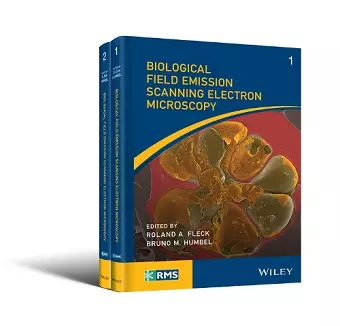Biological Field Emission Scanning Electron Microscopy, 2 Volume Set
Bruno M Humbel editor Roland A Fleck editor
Format:Hardback
Publisher:John Wiley & Sons Inc
Published:26th Apr '19
Currently unavailable, and unfortunately no date known when it will be back

The go‐to resource for microscopists on biological applications of field emission gun scanning electron microscopy (FEGSEM)
The evolution of scanning electron microscopy technologies and capability over the past few years has revolutionized the biological imaging capabilities of the microscope—giving it the capability to examine surface structures of cellular membranes to reveal the organization of individual proteins across a membrane bilayer and the arrangement of cell cytoskeleton at a nm scale. Most notable are their improvements for field emission scanning electron microscopy (FEGSEM), which when combined with cryo-preparation techniques, has provided insight into a wide range of biological questions including the functionality of bacteria and viruses. This full-colour, must-have book for microscopists traces the development of the biological field emission scanning electron microscopy (FEGSEM) and highlights its current value in biological research as well as its future worth.
Biological Field Emission Scanning Electron Microscopy highlights the present capability of the technique and informs the wider biological science community of its application in basic biological research. Starting with the theory and history of FEGSEM, the book offers chapters covering: operation (strengths and weakness, sample selection, handling, limitations, and preparation); Commercial developments and principals from the major FEGSEM manufacturers (Thermo Scientific, JEOL, HITACHI, ZEISS, Tescan); technical developments essential to bioFEGSEM; cryobio FEGSEM; cryo-FIB; FEGSEM digital-tomography; array tomography; public health research; mammalian cells and tissues; digital challenges (image collection, storage, and automated data analysis); and more.
- Examines the creation of the biological field emission gun scanning electron microscopy (FEGSEM) and discusses its benefits to the biological research community and future value
- Provides insight into the design and development philosophy behind current instrument manufacturers
- Covers sample handling, applications, and key supporting techniques
- Focuses on the biological applications of field emission gun scanning electron microscopy (FEGSEM), covering both plant and animal research
- Presented in full colour
An important part of the Wiley-Royal Microscopical Series, Biological Field Emission Scanning Electron Microscopy is an ideal general resource for experienced academic and industrial users of electron microscopy—specifically, those with a need to understand the application, limitations, and strengths of FEGSEM.
Since the first commercial SEM (scanning electron microscope) was produced by Cambridge Instruments in 1965, the resolution,image contrast, and operability have improved dramatically which have turned field emission SEM into an increasingly valuable tool in the life science community. The challenge of life science microscopy is to provide the structural information for the correlation of structure and function in complex biological systems. For this reason, this two-volume edition comes as a welcome addition to the biologist’s library, since they encompass all the information needed to approach life science FEG SEM imaging challenges, including detailed descriptions of the instrumentation and analytical techniques currently available in the field.
There are many features of this edition that make it a useful resource for both the beginner and more advanced microscopist. First, the two volumes are composed of 31 self-contained chapters, each written by leading authorities on these subjects. Secondly, the chapters are richly illustrated and most chapters are complemented with a comprehensive, valuable, and up-to-date list of references. Accordingly, the user who seeks to purchase new equipment or select the appropriate technique will find useful information in both volumes.
In the initial nine chapters of vol. 1, the reader is given a comprehensive historical review and introduction to the possibilities of the current technology—choice of microscopy method and specimen preparation as well as cryo and room temperature options—edited by representatives from the major companies in the field. The three last chapters of vol. 1 are dedicated to a review of specimen preparation methods—chemical fixation and cryo methods—which are a must-read for any scientist in this field.
In vol. 2 in the first five chapters, the reader is introduced to more special applications and results of the techniques, spanning from pathology and infectious diseases, plant cell wall and nuclear envelope, yeast cell to food research.
The three following chapters focus on cryo-FEGSEM in biology, preparation protocols of vitrified cells for cryo-FIB microscopy, and ESEM (environmental scanning electron microscopy) including many valuable tips and tricks. Opportunities for "Life in 3D" research are described in great detail with chapters on Correlative Array Tomography and the Automatic Tape Collection Microtome followed by chapters on FIB-SEM for Biomaterials, FIB-SEM tomography, and 3D FEGSEM as a tool for structural biology. Vol. 2 is concluded with three chapters on image post-processing and resource management, which are relevant to all scientists—not just FEG SEM microscopists.
In conclusion, I highly recommend Biological Field Emission Scanning Electron Microscopy to anybody who wishes to implement and/or improve an available technology or method. This two-volume edition allows the reader to contemplate how to use existing equipment with some minor adjustments or simple application of sample preparation and analytical tools. Furthermore, this book provides a comprehensive analysis of the latest imaging technologies available in the field and should therefore be invaluable to any researcher who wishes to find a discussion of all these techniques and applications under one umbrella.
—Microscopy and Microanalysis (2020)
Klaus Qvortrup, Faculty of Health Sciences, University of Copenhagen, The Panum Institute, Denmark
ISBN: 9781118654064
Dimensions: 269mm x 188mm x 51mm
Weight: 2200g
752 pages